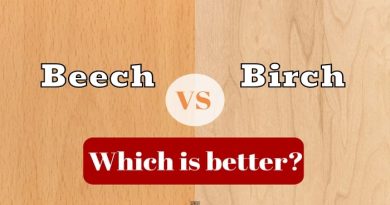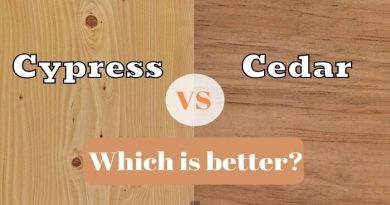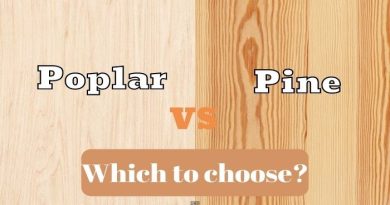Top 10 Water Resistant Woods (Must See)
Wood is one of the most common material in the manufacture of houses, furniture, home decoration pieces , etc. Its versatility allows it to be applied in different spaces and for the most diverse purposes. However, when it is designed for outdoor areas, the ideal is to opt for water resistant woods.
And today we are going to talk about a feature of wood that can be very useful for outdoor environments in humid environments, we are talking about water resistant woods .
Want to find out which water-resistant wood options are right for your work?
Today, Robinia, Douglas fir and Larch are the most common native woods used outdoors, especially when it comes to terrace construction or garden furniture because they withstand the effects of the water well and are also relatively hard and stable.
There are different types of wood, some of them are more water resistant than others. For those who want to know which wood is water resistant or which type of wood can get wet, we have brought you some options:
| Best Water Resistant Woods |
|---|
| 1.Ipe wood |
| 2.Teak |
| 3.Iroko wood |
| 4.Cumaru |
| 5.Peroba wood |
| 6.Merbau |
| 7.Robinia pseudoacacia |
| 8.Larch |
| 9.Elm wood |
| 10.Balau wood |
There are several water-resistant woods, but solid wood stands out for its low maintenance. These woods generally do not need chemical treatments and resist water, insects and weather wonderfully on their own. This article talks about which woods are most resistant to moisture and their application.
Water Resistant Woods
Here is a list with the top water resistant woods:
1.Ipe wood
Ipê wood is the first on our list, being the main wood reference when it comes to water resistance. It has high weather resistance and high durability.
It is not by chance that Ipê in Tupi means “hard shell”. Ipê wood can be used for the most varied types of projects given its resistance and versatile characteristics for the most varied types of environments.
It is not very glossy and because of its great durable characteristics it can be used from building bridges to stairs , baseboards and ceilings.
It is a wood that does not have a characteristic smell, which is ideal for people who are uncomfortable with the natural smell of wood.
Applications of Ipê wood in areas susceptible to water:
- Bridges;
- Railway Sleepers;
- Crosses;
- Fenders;
- Doors;
- Decks;
- Windows.
2.Teak
Currently, one of the best-known tropical species on the market is teak. This species is native to Southeast Asia and tropical areas of Africa and Latin America. Its dimensional stability and natural durability make this wood a great candidate for outdoor areas.
Also, its high degree of resistance prevents cracking and splitting usually caused by rain and sun exposure. Regarding the color, the golden brown tone is the usual one, but it is also found in a wide palette of reddish tones.
Teak wood is of the most reliable species on the market when it comes to water resistant woods. It is stable and its high degree of resistance prevents cracking and rupture usually caused by rain, sea water and the temperature variation, even to the attack of pests.
Its price is somewhat high, but the investment is worth it, since the natural oil it has makes it waterproof, so its resistance to water and cracking is very high.
Teak wood uses in water-susceptible areas:
- Floors;
- Foundation Footers;
- Pergola;
- Stairs;
- Decks.
If you want to make your wood waterproof you need to follow this easy step by step tutorial!
3.Iroko
Durable, strong and stable Iroko comes from Central and East Africa.
Iroko is a tropical wood well known for its water resistance and durability, and also for its interesting grain and coloration. It is a very versatile raw material that can be used in many areas, highlighting its use as flooring or platform .
Iroko wood is very similar in both appearance and properties to teak wood , which is why it is often called “African teak” and is replaced by it due to its lower cost, although the price variation is minimal.
Iroko wood, due to its properties of flexibility, resistance to water and insects, is the safest outdoors, and offers the maximum guarantees of duration outdoors.
In the same way, its easy work and handling guarantees surfaces with a very good finish, which is why its application in exterior carpentry and urban furniture is also common. Its color is positioned between white and yellowish brown that turns reddish brown with light.
Iroko wood uses in water-susceptible areas:
- Carpentry
- Outdoor furniture
- Shipbuilding
- Railway sleepers
- Decking and flooring both indoors and outdoors
- Construction of bridges
4.Cumaru
Cumaru wood has characteristics very similar to Ipe wood. It is characterized by its great durability and weather resistance, that is, places with high exposure to different weather conditions.
This type of wood has high density and without any type of treatment, cumaru is already characterized as a great option for humid environments or that will have direct contact with water.
Cumaru wood can be used to compose decks , floors , pergolas , stairs , tables , outdoor furniture, etc. It has a standardized format, without many color variations and gets a darker shade after applying the varnish or other type of finish.
Cumaru wood is in direct competition with Ipe, both with similar properties, but the latter with a lighter brown color than the former. This species of wood is native to Central America and northern South America.
It is characterized by its hardness and its excellent quality, which make it particularly suitable for exteriors . Being a versatile wood, its use is abundant: exterior floors, exterior and interior carpentry, veneers, turning, construction.
Cumaru wood uses in water-susceptible areas:
- Wooden Bridges;
- Floors;
- Pergola;
- Stairs;
- Posts;
- Piles;
- Props;
- Sleepers;
- Decks;
- Vessels.
5.Pink Peroba wood
Peroba-Rosa is another noble wood that can be used in environments with humidity. Unlike Ipê and Cumaru, this wood has a unique and very beautiful tone with lighter, pink and orange tones. It has high density, excellent weather resistance and excellent durability.
Peroba-Rosa is also widely used to build furniture for outdoor environments such as tables , chairs, cabinets, shelves, doors , etc.
It is a wood with excellent durability and despite being very hard and water resistant, it has a smoother texture and can have different types of finishes from more rustic characteristics to more luxurious finishes.
Choosing Pink Peroba-Rosa as wood for an outdoor environment will certainly bring a lot of sophistication and beauty to the place.
Uses of Peroba-rosa wood in areas susceptible to water:
- Garden Sleepers;
- Crosses;
- Doors;
- Windows;
- Banks;
- Tables;
- Chairs.
6.Merbau
This wood species descends from the family Leguminosae (Caesalpiniaceae). It is mainly from Southeast Asia(Indonesia and Malaysia) and the islands of the Southwest Pacific, planted in Madagascar.
Is a very durable (stronger than oak) and moisture resistant wood species with a very unusual texture and pattern on the surface. Most often used in decoration because of its aesthetic qualities. Exotic and expensive wood.
Merbau is the king wood species in Australia (called Kwila) and New Zealand for pontoons, marinas, and of course deck coverings and can be compared to Ipé wood from Brazil.
Merbau has the great advantage of being a very hard wood. Harder than oak and more resistant to shocks, parquet has a very long lifespan. In addition, this density gives this species good resistance to shocks and time.
Merbau is weatherproof and highly resistant to fungal and insect infestation (resistance class 1-2). When it rains, however, the wood produce yellowish-green to brownish substances. Its water resistance obviously remains its main asset. Indeed, merbau parquet can be laid indoors or outdoors, it all depends on your desires.
Uses of Merbau wood in areas susceptible to water:
- Exterior carpentry: door, patio door, window
- Exterior cladding, siding, clapboard
- Structure and bridge in contact with the ground and fresh water
- Planked and boat deck
- Terrace on one level, swimming pool deck
- Shipbuilding
7.Robinia pseudoacacia (black locust)
If a weatherproof, hard and very durable wood is required, Robinia pseudoacacia is a very good choice, being the most water-resistant European woods.
Interesting for outdoor use and as construction wood is the very low deformation and the very low shrinkage of robinia wood. Even if it is heavily soaked in water, it remains very dimensionally stable.
Robinia pseudoacacia is naturally protected from the weather, fungi and insects. Robinia wood has always been (and still is) very popular in shipbuilding because of its high resistance.
The robinia wood as “acacia” is almost the most popular wood for garden furniture and all constructions that are used outdoors without weather protection.
Robinia wood can also withstand the long-term effects of weather and moisture on the wood, as well as frost and cold. Completely untreated, its service life is already between 15 and 25 years.
Tropical woods with similar properties (such as teak) are many times more expensive so robinia wood has long since established itself among the masses and can last up to 50 years.
8.Larch
Larch wood is extremely weather-resistant whether against rain, heat or wind. If the wood is used outside, it only develops a silver patina due to the weather. As a material for roof constructions or as roof shingles, the wood has to be able to withstand a lot.
Larch wood , can be said to be one of the most used materials in the carpentry and construction sector, both for the construction of simple structures and coatings, as well as for boats and bridges especially in places with high humidity.
Its traditional use in construction stands out, the resin contained in the larch wood itself acts as a flashing and allows high protection against air and humidity, in addition, larch wood is not subject to splitting and is rarely attacked by insects .
Whether decking, garden furniture, a fence, roof structures, bridge, ship and boat building: larch wood is versatile in terms of it’s waterproof properties. The great advantages of the reddish wood: its longevity and weather resistance.
Among the uses of larch wood we can mention both interior and exterior carpentry (it is a wood that is very resistant to the action of water), telephone and light poles, and bridges and walkways. Its traditional use in construction stands out and in certain places in France and Italy it was used for the construction of wine barrels.
9.Elm wood
It is one of the most durable waterproof woods, it can last for years submerged in fresh or salt water and maintain without problems.
American elm wood, like its European cousin, has a good resistance to water, in fact it is used for the construction of ships but also for port areas and elements immersed in basins. It is also characterized by good workability, medium flexural and breaking strength and has low stiffness.
Being waterproof, it is ideal for humid spaces such as the kitchen or bathroom and outdoor spaces such as terraces.
The passage of time usually affects elm wood, which adds to its beauty since certain imperfections typical of natural wood appear. Also, if you place it close to natural light, you can darken it to give a more classic touch to the piece.
Uses of Elm wood in areas susceptible to water exposure:
- Floors.
- Manufacture of structures, including submerged water pipes or poles in mines.
- Boat building.
- Planking placed above the piling
- Hydraulic constructions
10.Balau wood
Balau woood is an interesting type of wood with water-repellent properties , most often used as a floor covering and finishing material, while untreated or grooved wood always spreads on the floor, since after processing the balau becomes very slippery.
Like many other tropical woods, Balau grays very quickly when exposed to the weather. Balau is a heavy wood and a weatherproof wood with a density of 0.92 g/cm³.
Balau’s main areas of application are particularly water resilient constructions, such as for bridges, railway sleepers or floors.
A growing market for this wood is found in patio and deck flooring and patio furniture. Although not as good as teak, it is often used and sold as a substitute as Balau is quite a bit cheaper.
Classification of water resistant woods
In woodworking or in carpentry, we pay attention in priority to the exposure of the wood to humidity. Because all wood does not resist water in the same way, whether with heat treatment or naturally. Wood is classified into five categories , according to its resistance to water:
Class 1: Lists wood intended for interior use only, sheltered from all weather. This class is the least resistant to moisture.
Class 2: This wood will resist humidity above 20% in a very exceptional way.
Class 3: This type of wood more readily accepts humidity above 20%. Usually placed outdoors, however, it will not be in direct contact with soil or water.
Class 4: Wood is quite water resistant and can be in direct contact with the ground and fresh water; this is how posts, pontoons or fences must be made of this type of wood.
Class 5: This is the highest water resistance class . Class 5 woods can be immersed in salt water and still resist it. Very durable, they are very popular and come from tropical forests like the Brazilian Amazon. They are also the most expensive woods.
Interior flooring timbers will be class 1 or 2, while decking timbers will be class 3 or 4. Class 5, extreme, is a rather rare case in our individual use of timber, class 4 being often quite sufficient.
| Wood class | Water resistance | Common uses | Examples of woods |
| 1 | Interior | furniture, flooring, paneling, joinery and interior fittings | oak, poplar, ash, cherry, hornbeam, maple, walnut |
| 2 | Indoors or under cover | frames, frameworks | oak, chestnut, beech, pine |
| 3 | Outside | exterior joinery, cladding, sheltered terraces, gates | chestnut, oak, Douglas pine, Larch, red cedar, Scots and maritime pine, Iroko |
| 4 | Exterior or Contact with water | posts, balconies, terraces, pergolas, benches, crosspieces, stakes, gratings, logs, outdoor games | Robinia, oak after treatment, Scots and maritime pine after treatment, cumaru, teak, azobe |
| 5 | In contact with sea water | pontoons, submerged pillars | ipe, itauba, macaranduba,merbau |
Water resistant wood for outdoor use
- Outdoor woods requiring maintenance – Outdoor woods such as garapa , pine , fir , sipo , douglas , ash , sitka and spruce are endowed with excellent strength, stability and hardness, but compared to the previous ones they require periodic surface treatments to maintain unchanged the color, which may fade over time.
- Maintenance-free outdoor woods – The best outdoor woods do not need treatments and maintain color and brightness unaltered over time, and also boast excellent resistance to atmospheric agents, humidity, water and time. Among those with these characteristics we must include chestnut , sequoia , bamboo , afrormosia , arice , azobé , olive , oak , acacia , cypress , ipe , massaranduba , iroko and teak .
Water resistant woods for bathroom
There are numerous different types of wood that offer a wide visual spectrum with different colors and grains. One thing is clear: wood is hygroscopic, meaning it absorbs moisture. However, some types of wood cope better with the high and, above all, strongly fluctuating humidity in the bathroom than others.
These woods are suitable for bathroom use:
- Types of wood such as merbau, jatoba or teak are suitable for the bathroom. Tropical woods are suitable because they come from warm, humid areas to which they have adapted over time.
- Suitable local types of wood are douglas fir, walnut, oak or larch . If you want to do without tropical woods but like their look, then smoked oak with its dark color is a good alternative.
Wood that has a lower resistance to moisture, but feels comfortable when exposed to water and steam:
- Bamboo;
- Corkwood;
- Merbau;
- Red tree;
- Teak;
- Larch;
- Cedar;
- Balau;
In the bathroom, tropical woods such as wenge, jatoba, ipe, iroko or the well-known teak are the most recommended, because they are highly resistant to water and to the special humidity conditions in this room.
The tropical wood is perfectly adapted to high humidity and is therefore ideally suited for bathroom furniture or accessories made of wood. In addition, bamboo is robust and less expensive than other tropical woods.
But, these options can be expanded with common varieties such as chestnut, oak, fir or larch. The key to its maintenance and durability is to waterproof the wood .
If you are going to use wood in the furniture or shelves, the range of options is greater since they do not suffer direct contact with water.
Maple, birch, beech, spruce, pine, mahogany or teak are well suited for the bathroom. The advantage of teak: It is a very durable wood and hardly warps when wet.
However, pine wood should not be planned for use in areas where direct splashing water can occur, as it can form mold more quickly if it is damp. Bamboo wood, on the other hand, seems to be almost ideal for use in the bathroom and is therefore extremely popular.
Oak or robinia wood also has a naturally high level of water resistance. However, oak wood in particular should be pre-treated with special care products, as the high proportion of tannic acid can cause stains or other contamination when it comes into contact with cleaning products.
If you want to use chipboard or fiberboard furniture in the bathroom, it should be glued with a waterproof glue that does not swell when it comes into contact with moisture.
Water resistant wood for boats
White fir, spruce, ash, iroko, mahogany, oak, teak. These are just some of the most common woods in the nautical sector, in which soft and hard woods find space according to the type of component to be made: structures, masts, beams, interior furnishings.
Pine, larch, Douglas fir, western red cedar, chestnut and oak represent the most water resistant woods for exterior coverings , even without treatment. White fir and spruce will require protection to be able to last over time.
Wood is a very water resistant material . For wood to be damaged by water , it must be exposed to it to a large amount over a long period of time. So when building wooden structures , only the outer envelope must be resistant.




